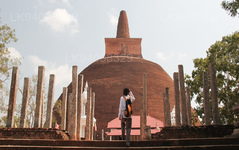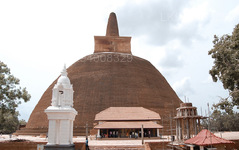
مدينة أنورادهابورة
أنورادهابورة هي إحدى عواصم سريلانكا القديمة، وتشتهر بآثارها المحفوظة جيدًا للحضارة السريلانكية القديمة. تقع المدينة، المدرجة حاليًا على قائمة اليونسكو للتراث العالمي، على بُعد 205 كيلومترات شمال العاصمة الحالية كولومبو في سريلانكا.
Abhayagiri Dagoba
Abhayagiri Vihāra was a major monastery site of Mahayana, Theravada and Vajrayana Buddhism that was situated in Anuradhapura, Sri Lanka. It is one of the most extensive ruins in the world and one of the most sacred Buddhist pilgrimage cities in the nation. Historically it was a great monastic centre as well as a royal capital, with magnificent monasteries rising to many stories, roofed with gilt bronze or tiles of burnt clay glazed in brilliant colors. To the north of the city, encircled by great walls and containing elaborate bathing ponds, carved balustrades and moonstones, stood "Abhayagiri", one of seventeen such religious units in Anuradhapura and the largest of its five major viharas. One of the focal points of the complex is an ancient stupa, the Abhayagiri Dagaba. Surrounding the humped dagaba, Abhayagiri Vihara was a seat of the Northern Monastery, or Uttara Vihara and the original custodian of the Tooth relic in the island.
The term "Abhayagiri Vihara" refers not only to the complex of monastic buildings, but also a fraternity of Buddhist monks, or Sangha, which maintained its own historical records, traditions and way of life. Founded in the 2nd century BC, it had grown into an international institution by the 1st century AD, attracting scholars from all over the world and encompassing all shades of Buddhist philosophy. Its influence can be traced to other parts of the world, through branches established elsewhere. Thus, the Abhayagiri Vihara developed as a great institution vis‑a‑vis the Mahavihara and the Jetavana Buddhist monastic sects in the ancient Sri Lankan capital of Anuradhapura.
It is recorded in the chronicle that Abhayagiri Dagaba was established by King Valagamba during the period of his second reign, from 89-77 B.C.E. A young Brahmin named Tiya (Tissa) declared war against him. Tiya was deluded by the prophecy of another Brahmin that was destined to be king. Before the arrival of Bhikkhu Mahinda, who brought Buddhism to the island, Brahmins held the highest place in society. After the establishment of the Buddhist sangha on the island, however, they lost their supremacy, and were replaced by the sangha. Some Brahmins converted to Buddhism, while others revolted. Tiya, who enjoyed the support of his community, lived both in and outside of Sri Lanka, and was therefore very powerful.
نبذة عن منطقة أنورادهابورا
أنورادهابورة تابعة لمقاطعة شمال وسط سريلانكا. تُعد أنورادهابورة إحدى العواصم القديمة لسريلانكا، وتشتهر بآثارها المحفوظة جيدًا للحضارة السريلانكية القديمة. تقع المدينة، المدرجة حاليًا على قائمة اليونسكو للتراث العالمي، على بُعد 205 كم شمال العاصمة الحالية كولومبو في سريلانكا. تضم مدينة أنورادهابورة المقدسة وفي محيطها عددًا كبيرًا من الآثار. تتكون الآثار من ثلاثة أنواع من المباني: داجوبا، ومباني رهبانية، وبوكونا (برك). كانت المدينة تتميز ببعض من أكثر أنظمة الري تعقيدًا في العالم القديم، وتقع في المنطقة الجافة من البلاد، وقد بنت الإدارة العديد من الخزانات لري الأرض. معظم السكان من السنهاليين، بينما يعيش التاميل والمسلمون السريلانكيون في المنطقة.
نبذة عن مقاطعة شمال الوسط
مقاطعة شمال الوسط وهي أكبر مقاطعة في البلاد تغطي 16٪ من إجمالي مساحة البلاد. تتكون مقاطعة شمال الوسط من منطقتين تسمى بولوناروا وأنورادهابور. أنورادهابور هي أكبر مقاطعة في سريلانكا. تبلغ مساحتها 7128 كيلومترًا مربعًا. تتمتع مقاطعة شمال الوسط بإمكانيات عديدة للمستثمرين لبدء أعمالهم التجارية، وخاصة الزراعة والصناعات القائمة على الزراعة وقطاعات الثروة الحيوانية. يعتمد أكثر من 65٪ من سكان مقاطعة شمال الوسط على الزراعة الأساسية والصناعات القائمة على الزراعة. كما أطلق عليها NCP اسم "Wew Bendi Rajje" نظرًا لوجود أكثر من 3000 خزان متوسط وكبير الحجم في المقاطعة. سري ماها بودييا، ورووانويلي سيا، وتوباراما داجيبا، ودير أباياجيري، وبولونارووا رانكوت ويهيرا، ولانكاثيليك خائفون














